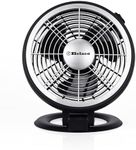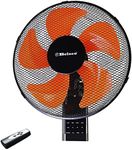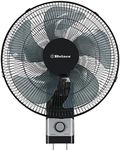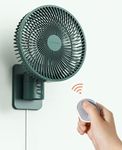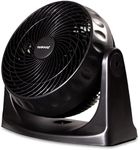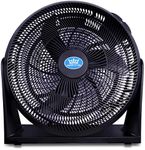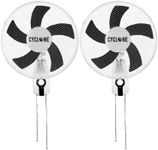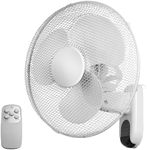Buying Guide for the Best Wall Mount Fans
When choosing a wall-mount fan, it's important to consider the specific needs of your space and how the fan will be used. Wall-mount fans are great for saving floor space and providing targeted airflow in specific areas. They are ideal for rooms where floor or table space is limited, such as garages, workshops, or small bedrooms. To find the best wall-mount fan for your needs, you'll want to consider several key specifications that can affect performance, convenience, and suitability for your environment.Size and Blade DiameterThe size and blade diameter of a wall-mount fan determine how much air it can move. Larger fans with bigger blades can circulate more air, making them suitable for larger spaces or areas that require significant airflow. Common sizes range from 12 inches to 24 inches. If you're looking to cool a small room or a specific area, a fan with a smaller blade diameter might suffice. For larger spaces or if you need to move air across a wider area, opt for a fan with a larger blade diameter.
Speed SettingsSpeed settings allow you to control the airflow intensity of the fan. Most wall-mount fans come with multiple speed settings, typically ranging from two to three speeds. This feature is important because it gives you flexibility in adjusting the fan's performance based on your comfort needs and the room's temperature. If you need precise control over airflow, look for a fan with more speed settings. For basic use, a fan with two or three speeds should be sufficient.
OscillationOscillation refers to the fan's ability to move side to side, distributing air more evenly across a room. This feature is important if you want to cover a larger area with airflow or if the fan is intended to cool multiple people or areas. Fans with oscillation can provide a more uniform cooling effect. If you need targeted airflow in a specific direction, a non-oscillating fan might be more appropriate. Consider your room layout and cooling needs when deciding on this feature.
Noise LevelThe noise level of a fan can significantly impact your comfort, especially if the fan is used in a bedroom or office. Fans are typically rated in decibels (dB), and a lower dB rating means a quieter fan. If you are sensitive to noise or plan to use the fan in a quiet environment, look for models that are specifically designed to operate quietly. For areas where noise is less of a concern, such as a garage or workshop, noise level might be less critical.
Installation and Mounting OptionsInstallation and mounting options refer to how the fan is attached to the wall and how easy it is to install. Some fans come with adjustable brackets or mounts that allow for flexible positioning, which can be important for directing airflow precisely where you need it. Consider the ease of installation and whether you have the tools and skills required to mount the fan securely. If you prefer a hassle-free setup, look for fans that come with clear instructions and all necessary mounting hardware.
Remote Control and TimerA remote control and timer feature add convenience to operating your wall-mount fan. A remote control allows you to adjust settings from a distance, which is particularly useful if the fan is mounted high on a wall. A timer can help you save energy by automatically turning the fan off after a set period. If you value convenience and energy efficiency, look for fans that offer these features. For basic use, these features might not be necessary, but they can enhance the overall user experience.
